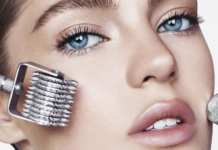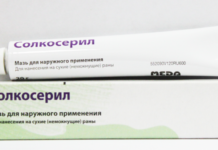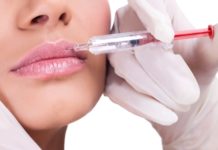Not only women but also men dream of having perfect facial features. Unfortunately, not all people are gifted with a correct and beautiful appearance from nature. Until the development of cosmetic surgery and invasive cosmetology, poor appearance was a sentence for the rest of my life. However, today there are many ways to correct certain areas of the face and body. One of these methods is fillers, which are used in cosmetology to fill voids and visually increase the volume of a particular area.
Material Content:
- 1 What are fillers?
- 2 What are
- 3 On what basis are
- 4 Filler Insertion Procedure
- 5 The rehabilitation period after the procedure
- 6 Pros and cons of this drug
- 7 Duration and number of procedures to achieve the result
- 8 Photos before and after the procedure
- 9 Which is better, biorevitalization or fillers?
- 10 Contraindications
- 11 Possible complications
What are fillers?

Fillers are gel-like fillers that are used to correct tissue volume upwards. Preparations of this group can be absorbable, having a temporary effect, or non-absorbable, permanent. Non-absorbable fillers are practically not used today. Refusal from them is associated with a high risk of filler migration with age-related changes in the site of its localization (the volume of muscle and adipose tissue decreases, after which the filler drains into the resulting voids). The effect of the absorbable variety of the filler lasts for 6-24 months, after which a second procedure is required.
Depending on what part of the body the filler is intended for, it can have a different density.This indicator varies from 16 to 25 mg / ml. The density of the drug also depends on what material it was made on the basis of.
Distinguish:
- Collagen fillers - bovine or human collagen is used to make the product;
- Synthetic fillers - they include synthetic components (mainly non-absorbable varieties of drugs);
- Autofillers - are made on the basis of the patient’s own adipose tissue taken from other parts of the body.
The introduction of the filler is done by injection, on an outpatient basis. As a rule, the result is noticeable immediately after the end of the manipulation. At the same time, the resulting picture may be distorted by a small edema, which disappears within a few days.
Note: Botox and fillers should not be confused. The first is a botulinum toxin, in small doses that can relax facial muscles and smooth wrinkles in this way. Fillers, in turn, make up for the missing tissue volume. Obviously, both the goals and the mechanism of action of these funds are different.
What are
In general, fillers do not have clear differences in application areas. However, practice has shown that the best results can be achieved if you use a certain kind of drug in each part of the body.
Face fillers
Face fillers are mainly made of polycaprolactone, which is a complex of microspheres. The composition not only mechanically fills the necessary zones, but also acts in a manner similar to hyaluronic acid. Smoothing of wrinkles occurs due to mechanical stretching of the skin and as a result of the revitalizing action of the filler. The drug is completely eliminated from the body within a year, however, the collagen frame, which has formed around the spheres of the filler, continues to maintain the tissue in position. Therefore, the time of action of funds based on microspheres significantly exceeds the time they spend under the skin.
Cheekbone fillers
Fillers are introduced into the area of the cheekbones, making it possible to replenish a relatively large volume of tissues. For this purpose, auto-compositions made from the patient’s own adipose tissue can be used. The procedure is used not only to smooth the skin, but also to return to the face the rounded features that existed in youth. After the introduction of the filler, the volume of the cheekbones increases. The effect lasts for 1-2 years.
Lip fillers
Lip fillers almost always include hyaluronic acid. This substance attracts liquid molecules to itself, which allows you to make lips more puffy and voluminous, reduce the size of nasolabial folds, smooth wrinkles. In addition, the acid stimulates the synthesis of proteins such as collagen and elastin, which give the tissues firmness and elasticity.
Fillers on the forehead
The introduction of fillers in the forehead is justified if wrinkles with botulinum toxin and pure hyaluronic acid cannot be smoothed out. The volume of the drug needed to correct one deep wrinkle does not exceed 0.5 ml. In this case, you should choose a tool with a high degree of viscosity, intended for patients who have crossed the forty-year mark. Such a composition will achieve a maximum and lasting effect. The filler manufacturer itself, whether it is the notorious juvederm or restylane, does not really matter. The effectiveness of the procedure depends on the skill of the doctor and the individual characteristics of the body.
Hair fillers
Fillers for hair restoration contain a large number of amino acids, keratin, collagen and other compounds necessary for healthy scalp. The introduction of drugs is carried out in a non-injection way.The product is mixed with water, given a little infusion and evenly distributed throughout the hair. After that, the treated areas are covered with cellophane for 20 minutes, and after this period they are rinsed with running water without using shampoo.
On what basis are
As mentioned above, fillers can be made on various bases. There are five basic chemicals that can be used by the manufacturer.
These include:
- hyaluronic acid;
- collagen;
- poly-L-lactic acid;
- calcium hydroxyapatite;
- polymethylmethacrylate microspheres.
Each of these substances has its own characteristics, so they should be considered separately.
Based on hyaluronic acid

Hyaluronic acid fillers have all the properties of this component. The drugs contribute to the accumulation of fluid in the tissues, mechanically fill the voids, and also stimulate the production of their own elastin and collagen. The combination of these properties makes fillers of this type the most popular and common.
Collagen Based
Collagen fillers are an obsolete variety of these drugs, which has been in the arsenal of cosmetologists since the 70s of the last century. Protein derived from the tissues of cows, pigs or humans is a cheap raw material. This ensures a low cost of the product. If it gets under the skin, such a filler, figuratively speaking, freezes, forming sedentary complexes. At the same time, the patient feels as if the treated area is numb. In addition, collagen-based fillers often cause allergic reactions.
Based on poly-L-lactic acid
Fillers based on poly-L-lactic acid (PLLA) have a predominantly stimulating rather than filling effect. The filling effect that develops immediately after the administration of the drug disappears after a few days. In this case, poly-L-lactic acid stimulates the production of its own collagen, which fills the cavity. Fillers made using PLLA to achieve the desired result require 3-5 procedures. The result is a pronounced and natural filling effect. In cosmetology, poly-L-lactic acid is not often used, as salon clients want to achieve the desired effect after the first procedure.
Based on Calcium Hydroxyapatite
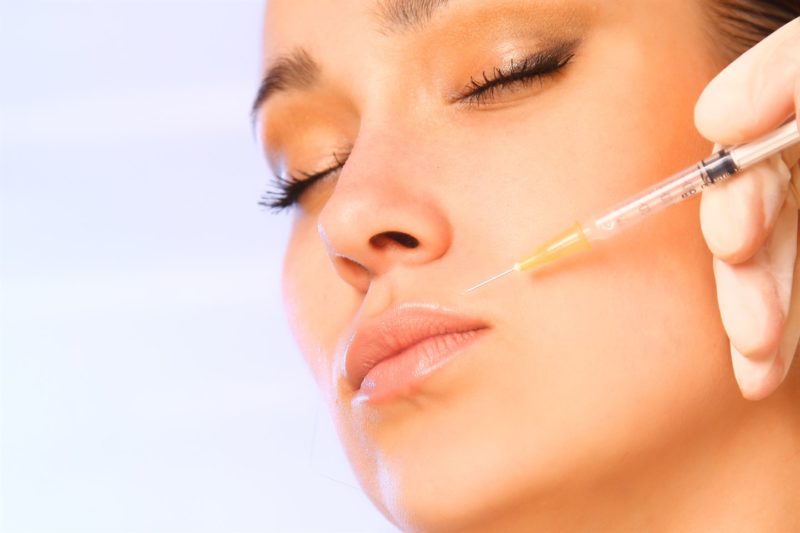
Calcium hydroxyapatite is the main building material for human bones. However, the fillers include its synthetic variety, obtained by artificial means. Preparations based on calcium compounds are the heaviest of all existing fillers. Introduced deep under the skin, evenly distributed over several days, stimulate the formation of a collagen frame. The effect of the use of calcium hydroxyapatite lasts an average of 9-12 months. This type of filler is indicated when it is necessary to fill large volumes in the area of the nasolabial triangle. With a shallow administration of the drug, white streaks or a dead pallor of the skin in the treated area may appear.
Based on polymethylmethacrylate microspheres
Fillers consisting of polymethylmethacrylate microspheres also include bovine collagen. The drug has a suspension consistency. After introduction into the skin around the microspheres, a collagen frame is formed, and fibrosis is formed. Indications for use of this type of fillers are deep wrinkles. In practice, preparations based on polymethyl methacrylate are rarely used.
Note: polymethylacrylate - organic glass obtained from thermoplastic resin. The material is better known as plexiglass.
Filler Insertion Procedure

The introduction of fillers is not a complicated procedure, however, it requires certain skills from the doctor.Before manipulation, the treated area is washed thoroughly with soap and then dried with a towel. Next, the specialist treats the skin with an alcohol antiseptic, which can be used as:
- Ethanol;
- Alfaseptin;
- Betaseptin.
For anesthesia, surface or conduction anesthesia can be used. If it is planned to introduce filler to a shallow depth, a lidocaine patch is used, which removes the sensitivity of the skin and shallow layers of fiber. Before the deep administration of large volumes of the drug, anesthesia is carried out by injecting an anesthetic into the nerve bed, which innervates the necessary area.
Note: superficial application anesthesia is used to smooth out skin wrinkles, conductive - for contour plasty of cheekbones, nose, lips.
By itself, the process of introducing a solution of fillers can be carried out using a cannula or needle. The first option is used for volumetric and deep interventions, the second for superficial ones. The methods of administration vary depending on the goals. The doctor can inject the solution pointwise, linearly, in the form of parallel or intersecting lines. Spot injections are needed to smooth out small individual wrinkles. Linear and cross-administration is used when it is necessary to form a collagen frame and achieve a volumetric effect.
After completing the procedure, the specialist conducts a light massage of the treated area. This allows you to evenly distribute the solution under the skin and stimulate healing. Aseptic and other dressings are not applied to the site of intervention.
The rehabilitation period after the procedure
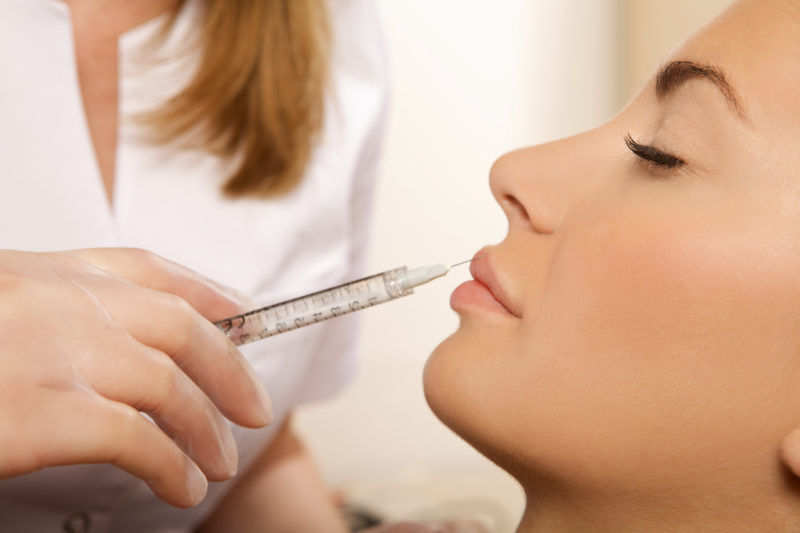
The rehabilitation period after the introduction of fillers takes 6-10 days. During this time, the patient may have edema, small subcutaneous hematomas, minor pain may occur.
During the rehabilitation period are contraindicated:
- intense facial movements;
- kisses
- visit to the bath and sauna;
- visit to the solarium;
- any thermal and intense mechanical effects on the treated zone.
Immediately after the procedure, it is recommended to put ice wrapped in fabric on the treated area. Local exposure to cold will reduce swelling and bruising. Hypothermia time should not exceed 15-20 minutes. Other rehabilitation measures, including taking antibacterial drugs, are not required.
Pros and cons of this drug
Modern fillers have many positive qualities, which include:
- the ability to correct wrinkles and skin folds without volumetric surgical intervention;
- low risk of allergic reactions;
- revitalizing action of fillers based on hyaluronic acid;
- lack of influence on muscle tissue, which fully preserves the facial expressions of the patient;
- the procedure takes place on an outpatient basis, does not require hospitalization and general anesthesia, rarely accompanied by complications;
- degraded fillers resolve over the course of a year, therefore medical errors during their administration are not irreversible.
Unfortunately, even the most modern fillers have a number of disadvantages, such as:
- inconsistent effect of fillers; annual repetitions of the correction procedure are required;
- the risk of displacement of the filler, which for a certain period of time can spoil the patient's appearance;
- high risk of vascular damage in the eye area during the procedure by an inexperienced specialist.
Despite the existing shortcomings, fillers maintain a leading position in the beauty market.
Duration and number of procedures to achieve the result

The total duration of the filler injection procedure usually does not exceed 25-30 minutes. During this time, anesthesia is performed, zones are determined, and the drug is administered. Correction of small superficial wrinkles requires a minimum of time.Deep correction and contouring can take up to 1 hour.
To achieve the result, one procedure is not always enough. If it is necessary to process large areas, the cosmetologist conducts 3-4 sessions of filler administration. The time interval between them is 3-4 days. During this time, the previous portion of the drug is absorbed and distributed, taking the position in which it will be until complete resorption.
Photos before and after the procedure
The result of the introduction of fillers is best evaluated visually, based on photographs taken before and after the procedure.

Correction of the nasolacrimal groove and nasolabial triangle - left “before”, right “after”.

Correction of the shape of the cheekbones with fillers.

Lip shape correction
From the above examples, we can conclude that fillers sometimes allow a fairly significant correction of facial features.
Which is better, biorevitalization or fillers?
Many women are wondering what to choose - fillers or revitalization procedure. Meanwhile, the choice is not difficult, if you understand the goals of each of these manipulations. You should consider each of them individually.
- Biorevitalization is a method of saturating the skin with moisture by introducing hyaluronic acid preparations into it. The procedure allows you to increase the moisture and tone of the skin, make them what they were in their youth. At the same time, facial features are not corrected. The effect of the procedure is directed directly to the skin.
- Fillers are a way to correct facial features by introducing filler into the necessary areas. Modern drugs also have a rejuvenating effect due to the hyaluronic acid contained in them. However, the purpose of their application is different.
As it became clear from the above, the procedures for revitalizing and introducing fillers have different goals. Therefore, the question of which is better is incorrect.
Contraindications

For almost all drugs, there is a list of conditions in which their use is prohibited. Fillers are not an exception, contraindications to which can be absolute and relative.
Among the absolute contraindications include:
- individual hypersensitivity and allergic reactions to the components of the product used;
- exacerbation of mental illness.
The list of relative contraindications includes:
- pregnancy;
- lactation;
- inflammatory skin diseases;
- the presence of permanent fillers;
- tendency to scarring;
- age less than 18 years.
Of course, the procedure is not carried out for patients who have severe somatic diseases, accompanied by a significant deterioration.
Possible complications
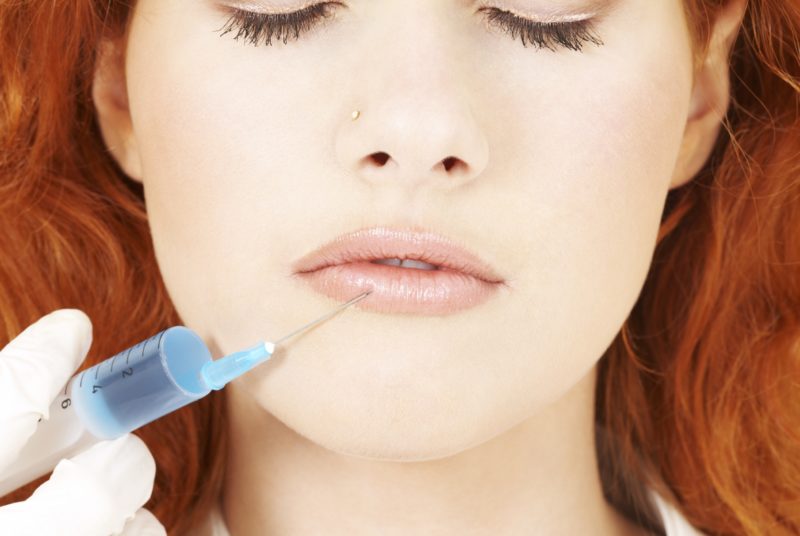
With the introduction of fillers, complications develop extremely rarely, however, this sometimes happens.
The most common complications include:
- Hematomas - bruising occurs when a blood vessel is damaged by a needle, as well as if a patient has coagulopathy.
- Edema - the severity of edema depends on the individual characteristics of the body and decongestion measures taken after the intervention.
- Filler migration - occurs when using low-quality compounds, as well as when a patient violates a doctor’s prescriptions.
- Tissue infection - occurs when a doctor does not follow the rules of asepsis and antiseptics.
- Hypercorrection (pumping) is the result of improper calculation of the filler dose by a specialist.
In general, fillers are a modern, relatively inexpensive and safe way to correct appearance and combat age-related changes. With their help, it is possible to smooth out wrinkles, change the shape of the cheekbones, lips, and adjust the size of the nasolacrimal groove. Subject to the rules of the procedure and the absence of contraindications, the use of fillers is not accompanied by complications that are characteristic of even correctly performed surgical intervention! Therefore, changing the appearance with injectable fillers is the best choice for women of all ages.


